The cat is under the table.
Change one word, and suddenly the cat could be on the table, beside the table, or through the table (if it’s a very talented cat).
These words — which we just tried changing — are called prepositions.
Prepositions are everywhere. In every sentence you speak, write, or think, prepositions are working to connect ideas, clarify relationships, and prevent linguistic chaos.
And this is exactly the topic of our discussion in this blog.
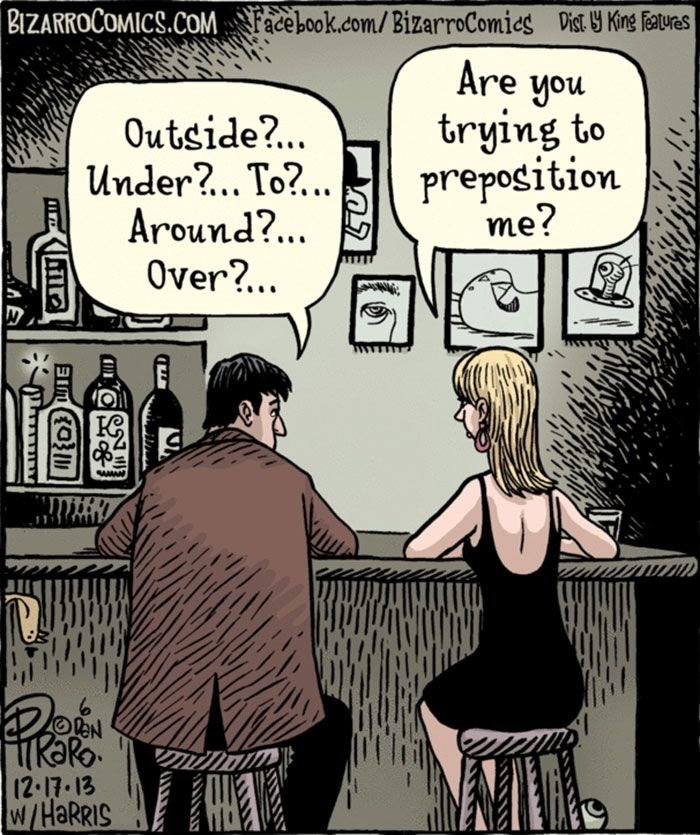
In this blog, we’ll cover everything you need to know about prepositions.
From understanding how they function in a sentence to recognizing their role and dependency on objects.
We’ll break down the structure of prepositional phrases, explain the different types, and show you how each is used with clear, real-life examples.
You’ll also find a categorized list of all prepositions, examples, and notes on modern vs. outdated usage.
Let’s dive in.
Key Takeaways
- Prepositions are connecting words that show relationships between nouns/pronouns and other sentence elements.
- There is a list of prepositions in English, categorized by function (time, place, direction, cause, manner).
- Prepositions always require an object to complete their meaning (dependency principle).
- Prepositional phrases function as either adjectives or adverbs in sentences.
- Academic writing uses more formal prepositions than conversational English.
- Common mistakes include wrong preposition choice, unnecessary additions, and literal translations.
What Is a Preposition?
A preposition is a word that shows the relationship between a noun or pronoun and another part of the sentence.
It helps explain where, when, how, or why something happens. In short, prepositions give context.
Their core job is to connect ideas related to:


Never Worry About AI Detecting Your Texts Again. Undetectable AI Can Help You:
- Make your AI assisted writing appear human-like.
- Bypass all major AI detection tools with just one click.
- Use AI safely and confidently in school and work.
- Time (e.g., before dinner),
- Place (e.g., on the table),
- Direction (e.g., towards the door),
- Cause or purpose (e.g., because of the delay), and
- Manner or method (e.g., by train).
Grammatically, a preposition is always followed by an object — usually a noun, pronoun, or gerund.
Together, they form what’s called a prepositional phrase.
The basic formula looks like this:
Preposition + Object = Prepositional Relationship
For example:
- The cat is under the table. → “Under” shows a spatial relationship.
- She arrived after lunch. → “After” connects the action to a point in time.
- They walked through the forest. → “Through” explains direction or movement.
- How Prepositions Work in a Sentence
Prepositions act as connectors. They link nouns or pronouns to other parts of the sentence and never stand alone. They always require an object to complete their meaning.
This is known as the dependency principle: a preposition is incomplete without an object.
For example,
“He sat on” is grammatically incorrect unless we know what on. It must be “He sat on the chair.”
Prepositions can appear in different positions within a sentence:
- At the beginning: “After dinner, we went out.”
- In the middle: “We went out after dinner.”
- Occasionally at the end, especially in questions or informal writing: “What are you thinking about?”
A common myth is that ending a sentence with a preposition is always wrong. But that’s outdated. In many cases, it’s more natural.
Correct: Where are you going to?” (acceptable)
Incorrect: To where are you going?” (technically correct but awkward)

- Prepositional Phrase Basics
A prepositional phrase consists of a preposition + its object, often with modifiers to add detail. Example: “in the messy kitchen”
- “in” = preposition
- “kitchen” = object
- “the messy” = modifiers
These phrases function in two main ways:
- Adjectival: Describe or limit a noun
- The book on the shelf is mine.
(“on the shelf” tells us which book)
- The book on the shelf is mine.
- Adverbial: Describe or limit a verb, adjective, or adverb
- She sat near the window.
(“near the window” tells us where she sat)
- She sat near the window.
You can have nested prepositional phrases where one phrase contains another:
→ The cat under the table in the kitchen is sleeping.
- “under the table” is the main phrase
- “in the kitchen” modifies “table”
Need help with a school project on prepositions?
Use Ask AI to get examples, explanations, and sentence breakdowns tailored to your topic.

Example:
- Give me 10 example sentences using prepositions of place, with explanations for each.
- Explain the difference between prepositions of time and direction, with examples for a 6th-grade project.
Types of Prepositions
When studying any comprehensive list of prepositions in English, you’ll notice they fall into distinct categories based on their function. Let’s understand them one by one:
- Prepositions of Time
These show when something happens. The list of common prepositions for time includes:
- At → for specific points in time
e.g., at 3 PM, at sunrise - On → for specific days or dates
e.g., on Monday, on July 4th - In → for longer periods (months, years, centuries)
e.g., in January, in 2020, in the 18th century
Duration prepositions like for, since, until, and during describe how long something happens. Examples:
- for three hours (duration)
- since 2010 (starting point)
- until midnight (endpoint)
- during the meeting (period within)
Sequence prepositions like before, after, by explain order or deadlines. Example:
- Submit by 5 PM. He left before lunch.
- Prepositions of Place/Position
These prepositions describe where something is located. Example:
- In = inside something (in a room)
- On = on a surface (on the table)
- At = a point or specific place (at the station)
- Under, over, beside, between, among = describe spatial relationships
Here are two ways to understand this:
- Dimensional thinking
“in the box” = 3D enclosure
“on the paper” = 2D surface
“at the door” = specific location
- Size relativity
You say “on a boat” (smaller) but “in a ship” (larger enclosure)
- Prepositions of Direction/Movement
These show motion from one point to another. Example:
- To = destination (go to school)
- From = origin (come from work)
- Into / out of = entering or exiting (into the house, out of the bag)
- Through / across = passage or movement (walk through the park, run across the street)
- Toward = in the direction of (move toward the door)
Use “to” for motion, and use “at” for position.
✅ “She went to the store.”
✅ “She is at the store.”
- Prepositions of Cause/Purpose
These explain why something happens. Example:
- Because of / due to / owing to = cause
→ The flight was delayed because of weather.
- For / in order to / with the purpose of = purpose
→ She studies hard in order to succeed.
Because of = cause linked to a noun
Correct: The delay was due to fog.
Incorrect: He was late because of he missed the train.
- Prepositions of Manner/Instrument
These show how an action is done or what is used to do it. Example:
- By, with, through, via
→ By train
→ With a key
→ Through practice
→ Via email
- Compound Prepositions
Compound prepositions are multi-word combinations that act as a single unit. Example:
- according to, in spite of, because of, in front of, on behalf of
Compound prepositions are often made from a simple preposition + a noun/verb + another preposition. There are 3 familiarity levels:
- in accordance with = formal
- because of = neutral
- thanks to = conversational
Master List of Common English Prepositions
- Alphabetical List of 100+ Prepositions
Here’s the complete list of all prepositions organized alphabetically for easy reference:
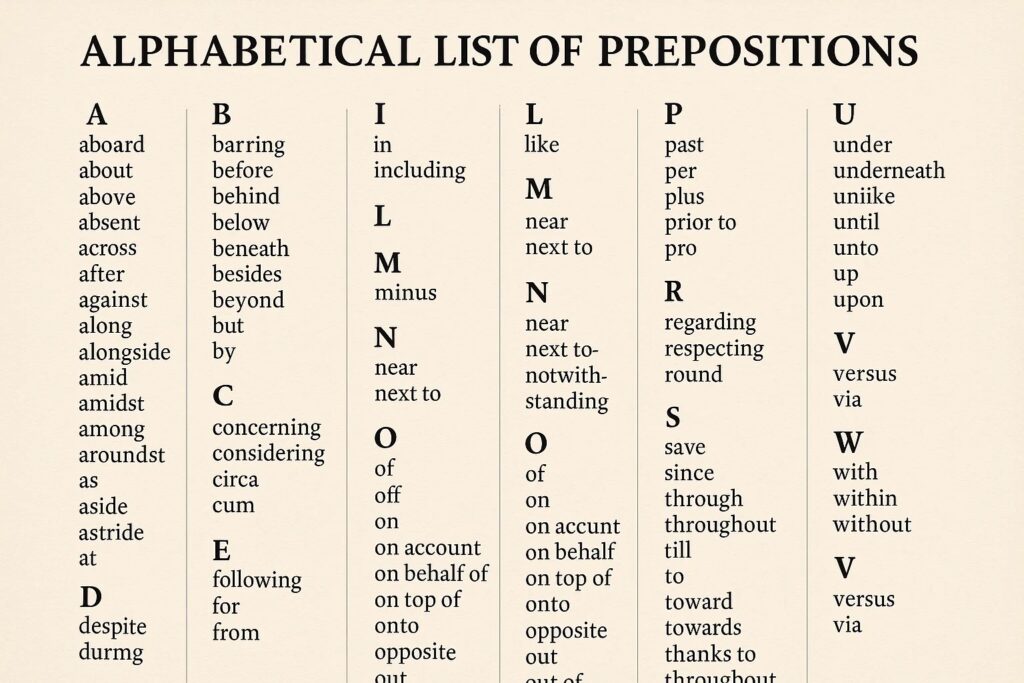
- List by Function or Type
This functional list of common prepositions helps you understand usage patterns:
| Category | Function | Core Prepositions | Notes/Tips |
| Time | Indicate when something happens | at – specific timeon – day/datein – month/year/period | “in” & “on” also apply to Place |
| Duration/Sequence | since, for, during, until, by, after, before | Learn these after mastering core 3 | |
| Place & Position | Show where something is | In, on, at | “on” = 2D surface“in” = 3D enclosed |
| Spatial Relations | under, over, behind, in front of, next to, between, among, above, below | Also used in Movement context | |
| Direction & Movement | Show movement from one place to another | to, into, onto, from, out of, off, through, across, toward, past | “to” = movement toward“at” = static location |
| Cause, Reason & Purpose | Explain why something happened | because of, due to, owing to, thanks to, for the sake of, in order to | Formal: due toCasual: because of |
| Manner, Instrument & Means | Describe how or with what something happens | by, with, via, through, using | by John = agentwith a hammer = tool (instrument) |
- Prepositions Used in Academic Writing
Prepositions are also used in academic writing.
But unlike conversational language, academic writing avoids vague or casual prepositions (like about, like, or plus) and favors more formal alternatives such as regarding, such as, and in addition to.
Different disciplines have prepositional preferences:
- Science: by means of, as a function of, in accordance with
- Humanities: in relation to, with regard to, on behalf of
- Business: in terms of, in compliance with, in response to
Here’s a list of common prepositions used in academic contexts:
- in accordance with
- in contrast to
- in relation to
- with respect to
- on the basis of
- in light of
- in addition to
- by means of
- in terms of
- in line with
- with regard to
- as a result of
- in the context of
- prior to
- subsequent to
- in response to
- for the purpose of
- in support of
- in opposition to
- in view of
Prepositions are easy to overuse or misuse in academic writing.
Too many prepositional phrases can make your sentences long and confusing, and choosing the wrong one can change your meaning.
Undetectable AI’s Grammar Checker can help you spot common issues like:
- Using too many prepositions in one sentence
- Picking the wrong preposition (e.g., different than instead of different from)
- Repeating phrases like in terms of too often
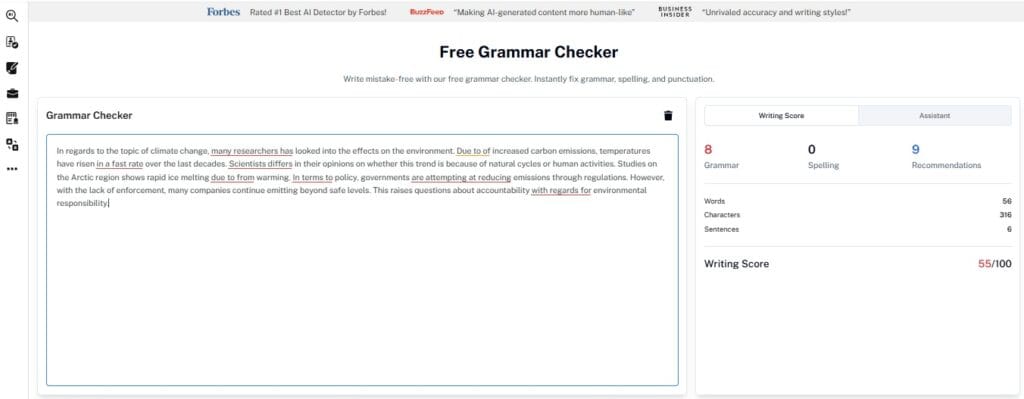
It tells you grammar mistakes, spelling mistakes and the recommendations.
It also shows the overall grammar score out of 100.
Examples of Prepositions in Sentences
Here are 20 examples of prepositions in sentences, showcasing the variety found in any comprehensive list of prepositions in English:
- The coffee is on the kitchen counter.
- We arrived at the airport around 8 PM.
- She was born in July.
- He drove through the tunnel during the storm.
- They’ve been waiting since morning.
- The package was sent by express mail.
- I placed the chair between the sofa and the table.
- The birds flew over the lake.
- We stayed at a hotel in Paris.
- The kids hid under the bed.
- She worked hard for her family.
- The road curves around the hill.
- This article was written for academic purposes.
- They succeeded because of their teamwork.
- The train passed through the town without stopping.
- He arrived after everyone had left.
- The painting on the wall is over 100 years old.
- She came from Australia last year.
- The teacher walked into the classroom quietly.
- The laptop was damaged due to water exposure.
Preposition Collocations and Phrases
Preposition collocations are fixed combinations where certain verbs, adjectives, or nouns naturally pair with specific prepositions.
Understanding these patterns is crucial when working with any list of all prepositions.
- Fixed Combinations: Verb + Preposition
Some verbs always require a specific preposition to complete their meaning:
- depend on, believe in, focus on, belong to, approve of
Example: She depends on her team to meet deadlines.
- Idiomatic Expressions
Idioms use prepositions in ways that can’t be understood literally:
- at odds with (in disagreement), in the loop (informed), on edge (nervous)
Example: He was at odds with his supervisor over the report.
- Dependency Patterns
Certain words demand specific prepositions. Changing them alters or ruins the meaning:
- interested in, good at, afraid of, responsible for
Example: She’s responsible for managing the entire project.
- Memory Strategies
Group prepositions by the word they commonly follow. For instance:
- Verbs + for: apply for, hope for, pay for
- Adjectives + of: afraid of, proud of, tired of
- Nouns + to: invitation to, solution to, answer to
- Usage Frequency
Some collocations appear constantly in everyday and academic English. Prioritize these:
- look forward to, take care of, deal with, participate in, contribute to
Common Mistakes and How to Fix Them
Here’s a breakdown of the most common issues when using any list of prepositions in English, and how to fix them:
- Using the Wrong Preposition with a Verb
Mistake: She depends of her parents.
Fix: She depends on her parents.
- Unnecessary Preposition After a Verb
Mistake: We discussed about the issue.
Fix: We discussed the issue.
- Preposition Omitted Where Required
Mistake: He applied the job yesterday.
Fix: He applied for the job yesterday.
- Literal Translation of Phrases
Mistake: She is married with a doctor.
Fix: She is married to a doctor.
- Wrong Preposition with Time Expression
Mistake: We’ll meet in Friday.
Fix: We’ll meet on Friday.
- Inaccurate Use of “Between” vs. “Among”
Mistake: She divided the money between five people.
Fix: She divided the money among five people.
- Using “In” Instead of “Into” for Movement
Mistake: He went in the room quickly.
Fix: He went into the room quickly.
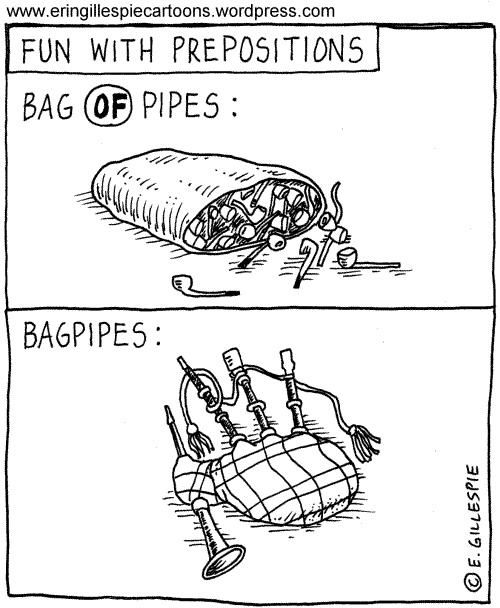
If you often get stuck with clunky or confusing prepositional phrases, using an AI Essay Rewriter can help.
It spots awkward parts like “discuss about” (which should just be “discuss”) or wordy phrases like “in the process of doing” (which can be “while doing”).
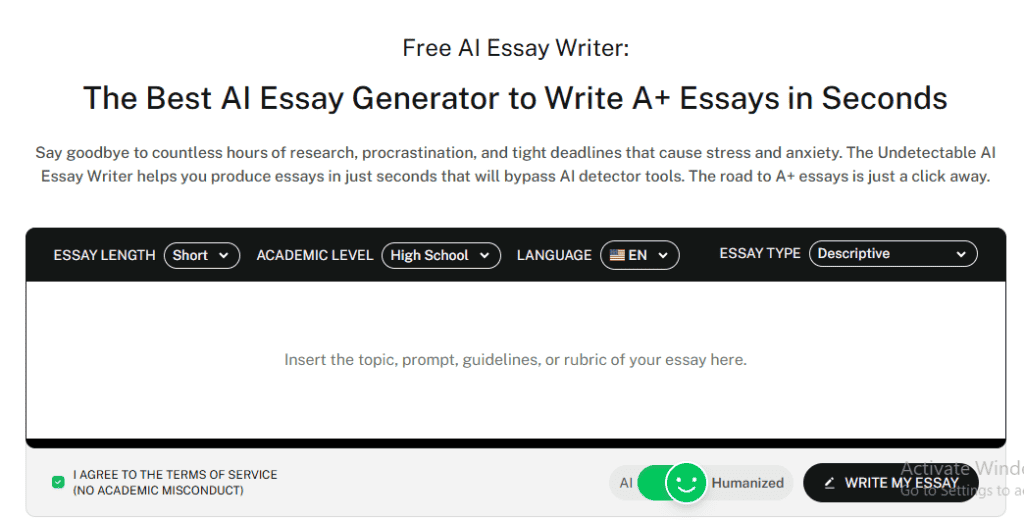
Instead of going through your whole essay line by line, the tool gives smoother, clearer versions automatically.
Scroll down and see what our AI Detector and Humanizer can do!
Final Thoughts
You made it through a complete list of prepositions. Impressive.
But now, will you use what you’ve learned, or will this knowledge sit in your brain?
There is a difference between knowing something about grammar and mastering them with constant practice. You have to choose the latter to have a solid grip.
How many times have you second-guessed a preposition mid-sentence?
These tiny hesitations add up, and create friction in your communication that most people never address.
Now you have the roadmap to eliminate that uncertainty completely.
So for the next 30 days, become hyperaware of your preposition choices.
Question them. Test them. Refine them.
Because the person who speaks and writes with prepositional precision is more persuasive, more professional, and more memorable.
Use AI tools like Ask AI if you still feel confused at any point of your learning.
And when you need a second opinion?
Let Undetectable AI fine-tune your grammar so your ideas come through crystal clear.
